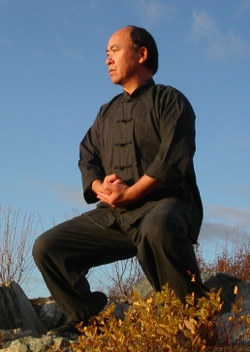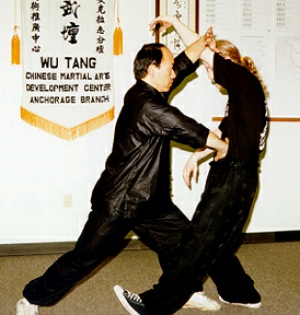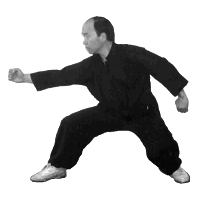STYLES:
TAI CHI
Description of Style

Chen style Tai Chi Quan is the oldest and the most martial of the four major family styles of Tai Chi. A very effective style, it is taught primarily as a fighting art, unlike its younger cousin Yang Style Tai Chi Quan, which often stresses the health aspects of the art (though it is also martial in nature).
In the Wu Tan Kung Fu and Tai Chi Institute, there are three levels of training in the Chen Style. The first level is the 36 Movement form – aka Xin Jia. It is done slowly with some fast and explosive movements. The second level is the Lao Jia or the Old Frame. It is quite similar to the 36, but there are 72 movements. The final level is the Pao Chui form (Cannon Fist). Pao Chui teaches how to issue jing (internal energy) and contains very fast movements.
The main principles of Chen Tai Chi Quan are: the development, practice, and mastery of "whole body connection", and the mental development and physical application of the "Dan Tien". These guiding principles are represented by the following ten essential points:

Suspend the head from above and keep it straight.
Depress the chest and raise the upper back.
Loosen the waist.
Differentiate between solidness and emptiness.
Lower the shoulders and sink elbows.
Use will and not force.
Connect the upper and lower portions of your body.
Unify both internal and external movements.
Practice continuity in movement.
Seek serenity in action.
History of Style

There is a popular folk story that credits a Daoist monk, Zhang San Feng, a master of Shaolin Chuan (Shaolin Fist style), for the creation of Tai Chi Quan. The story claims that one day, Zhang San Feng observed a fight between a crane and a snake. Zhang was impressed with how the snake did not fight against the crane's blows; it avoided the crane's hit. After realizing that force is not needed in combat, Zhang combined the Daoist teaching of opposites (the Yin and Yang theory), the fighting techniques of the crane and snake he observed, and the techniques he learned from Shaolin into what is now known as Taijiquan, the grand ultimate fist style.
This story is disputed by many Tai Chi practitioners. Historians believe that Tai Chi Quan was created in the Chen Village, Honan Province by Chen Wang Ting, an ex-military officer by combining arts and philosophy learned in his military career with his traditional family Fist. There is proof that Chen Wang Ting actually lived and practiced Tai Chi whereas it was never recorded in Chinese history that Zhang practiced or created Tai Chi Quan.
Similarly, there are many stories regarding the origin of Yang Style Tai Chi Quan. Most details of the story are consistent:
Yang, Lu-Chan was an accomplished fighter and martial artist who wanted to learn the Chen Family Fist – or Tai Chi Quan as it became known. He was rebuffed as the style was only taught to Chens. He then resorted to disguise and/or trickery to be invited into the household (some say he dressed as a beggar and swept the street in front of the Chen’s household). While in the compound, he was able to observe the Master Chen’s nighttime lessons to his family by watching with one eye through a hole in the wall (they all say this is so!). At this point the stories diverge greatly. Many Yang Style schools tell a version where Yang dramatically revealed himself in a heroic defense of the honor of the Chen Style while the Master was away and not there to face the challenger. However, another version is that he was caught and was going to be killed by the Chens; but instead, he was allowed to demonstrate his skill to the Master Chen. His skill was impressive enough to be allowed to live and leave and even to teach; but he was not allowed to publicly teach the fa-jing. This explains why the Yang forms do not demonstrate any Chan Si Jing or Fa Jing and the transmission of these jings in the system is limited to those few of Yang’s family and closed-door disciples he taught secretly.
The Yang Tai Chi of Wu Tan comes down though the Tai Chi and Jien Master Son, Wei-I who taught the officers and generals of the Warlord Li, Jing-Lin and specifically his General Zhang, Xiang-Wu – elder kung fu brother to Grandmaster Liu who founded Wu Tan.
Master Kurt Wong of the Wu Tan Kung Fu and Tai Chi Institute learned the Chen Style Tai Chi Quan from Master Adam Hsu of Taiwan. Master Hsu was encouraged by Grandmaster Liu to learn the Chen style from Sifu Tu Yi Che. Sifu Tu was a student of Chen Yen Hsin of the Chen Village . The style from this lineage is the Lao Jia, the original style. Chen Fa Ke's lineage (Chen Yen Hsin's nephew and student) teaches a different set called the Xin Jia, new frame, along with the Lao Jia. Master Adam Hsu also teaches a rare version of the Chen style, Hu Le Jia or Thunder Style Tai Chi Quan.
TOP



